GIZA
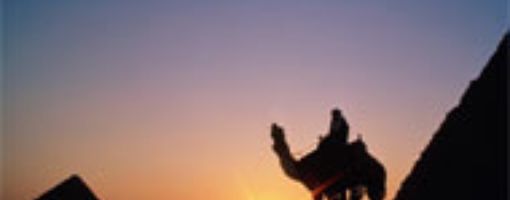
![]() Before describing the imposing and famous funerary complex at Giza wemight “journalist”, Herodotus, had to say about it on the testimony of variousforeigners who had lived in Egypt. Although Herodotus often criticized Egypt and its inhabitants henevertheless left us an incredible amount of preciousinformation.
Before describing the imposing and famous funerary complex at Giza wemight “journalist”, Herodotus, had to say about it on the testimony of variousforeigners who had lived in Egypt. Although Herodotus often criticized Egypt and its inhabitants henevertheless left us an incredible amount of preciousinformation.
He writes “Cheops left behind him a colossal piece of work, his pyramid.Up to the reign of Rhampsinitus, Egypt was excellently governed and veryprosperous. Cheops, his successor, compelled his subjects to labor as slaves forhim. Some were forced to drag blocks of stone from the quarries in the Arabianhills to the Nile, where they were ferried across and taken over others whohauled them to the Libyan hills. The work went on in three monthly shifts ahundred thousand men in a shift.
It took ten years to build the track along which the blocks were hauled,a work of hardly less magnitude than the pyramid itself, for it is 5 stadia long (923.5 meters), 10 orgyia wide(18.47 meters) and 8 orgyia high(14.78 meters) at its highest point, and is constructed of polished stone blocksdecorated with carvings of animals. It took ten years to build, including theunderground burial chambers on the hill where the pyramids stand. A cut was madefrom the Nile, so that the water so deviated turned the site of the pyramiditself took twenty years. It is square at the base, the length of each side, 8 plethras (2546.26 meters), beingequal to the height. It is made of polished, beautifully fitted, stone blocksnone of the blocks being less then 30 feet long (9.24meters)”.
Afterthis introduction Herodotus recounts thestory of the building of the Great Pyramid, giving us the most precise details, from the typically Egyptian stylisticcharacteristics to the costs involved for the work on this strangeedifice. «The pyramid was constructed intiers or steps, something likebattlements, and when the basewas completed the remaining blocks were lifted by a kind of crane made ofshort timbers onto the first tier. On this first tier there was anotherlifting-crane which rose the blocks a stage higher and then yet another whichraised them higher still. Each tier had itsown crane or it may be that they used the same one which, being easy to carry, they shifted up from stageto stage as soon as its load was droppedinto place. I describe the two procedures given in the two versions whichI have heard about.
The finishing of the pyramid started at the top and worked downwards,ending with the parts nearest the ground. An inscription on the pyramid in Egyptian characters records the amountsspend on horse-radish, onion and heads of garlic, and if I remember correctlywhat the interpreter who read me the inscription said, the sum involved was 1600talents of silver (41,884 kilogram’s). If this is true how much must have evenspent on the iron used, on other foodstuffs and on the clothing of thelaborers? Not to mention thetime it took, which cannot have been negligible, to quarry and haul the stoneand to build the underground burial chamber. Four centuries after Herodotus thehistorian Diodorus of Sicily *1st century B.C.) visited Egypt and inhis turn visited the pyramids which he considered to be among the seven wondersof the work. Like his predecessor,Diodorus was filled with amazement in front of this monument. «One must agree» he wrote, «thatthese monuments are superior to everything else one sees in Egypt not onlybecause of their enormous size and the prodigious sums which were spent onthem but because of the beauty of their construction». Diodorus then gives ushis version of how the pyramids were built. His account speaks of all threegreat pyramids which he presents as being a funerary ensemble of the IVthdynasty. The Great Pyramid is only one element of this ensemble, albeit the mostprestigious element and it cannot be studied or understood out of thiscontext. Like Herodotus, Diodorus of Sicily evaluates the sum spent onhorse-radish, onions and garlic for the laborers on the Great Pyramid at 1600talents, but unlike Herodotus he believed that these monuments did notcontain the bodies of the pharaohs which, in his version, had been buried insafe and secret hiding places. We shall not cite further Diodorus's text whichagrees, more or less, with that of Herodotus. We have only cited him at all inorder to show that the greatest writers of antiquity were all equallyimpressed by the beauty and uniqueness of the Egyptian funerarymonuments.
AtGiza the visitor is presented with one of the most beautiful sights created bythe hand of man. It is here that the Egyptian saying «Everybody fears Time butTime fears the pyramids» is mostapposite. Giza is the presentname given to the greatnecropolis of Cairo and it consistsof a plateau having an area of about two thousand square meters. TheSphinx together with the three Great Pyramids, those of Cheops, Chep-hren andMicerinus are found here. The latter has three small satellite pyramids. Thethree monuments are arranged diagonally but in such a way that none of them hides the sun from the other two. Typically each pyramid consistsof a funerary temple in the valley. The complex of Cheops is almost completely destroyed while that ofChephren is largely extant. The pyramid of Cheops is the largest of thethree. It was originally 146 meters high, today it is only 137 meters high, its truncated summitbeing a platform 10 meters square. Todaydie pyramid has completely lost itsexternal facing, thus revealing the enormous internal blocks ofstone over which one must laboriouslyclimb in order to reach the summit. However the stupendous view from the top makes the effort involved wellworth while. Chephren’s pyramid is the only one which still has, at leastat the top the smooth external facing. Although it was lower than Cheop'stoday it is in fact the same height because it is not truncated. It originallyhad red granite facing at the base.
Documents
SAKKARAH
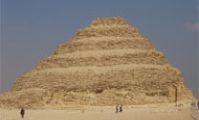
Themastaba tombs
As has already been mentioned a mastaba is the tomb of a bobel or I dignitary built to ...THE SPHINX
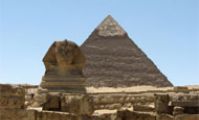
THE SPHINX
About 350 meters from Cheops's pyramid stands the Great Sphinx, known in Arabic as Abu el-Hol which ...THE SOLAR BARK
THE SOLAR BARK
Your Rating:
Overall rating: 0.000
Totally voted: 0
Comments
Weather in:
Exchange Rates
-
Archaeologists Discover a Tomb of Ptahmes in Egypt
Jun 01, 2010, rating: 0.000, 0 votes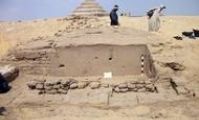 Egypt (Saqqara) - The Archaeology faculty at Cairo University has discovered a new tomb at Saqqara.
Egypt (Saqqara) - The Archaeology faculty at Cairo University has discovered a new tomb at Saqqara.
-
4,000-year-old priest's tomb unearthed in Egypt
Oct 20, 2010, rating: 0.000, 0 votes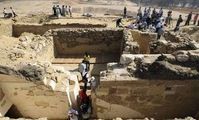 CAIRO (AFP) – Egyptian archaeologists have discovered the tomb of a priest who conducted prayer rituals before statues of a dead ...
CAIRO (AFP) – Egyptian archaeologists have discovered the tomb of a priest who conducted prayer rituals before statues of a dead ... -
Egypt announces discovery of 3400-year-old wall around Sphinx
Nov 03, 2010, rating: 0.000, 0 votes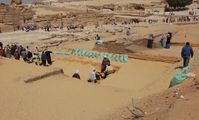 Egyptian authorities on Tuesday announced the discovery of a 3400-year-old enclosure wall around Giza's Sphinx, presumably erected to protect ...
Egyptian authorities on Tuesday announced the discovery of a 3400-year-old enclosure wall around Giza's Sphinx, presumably erected to protect ...








